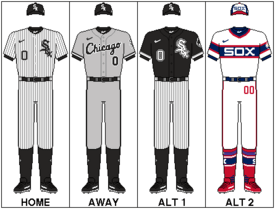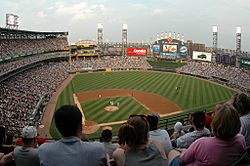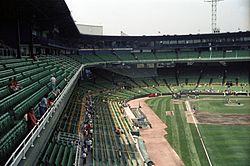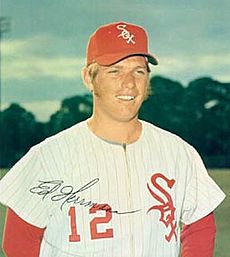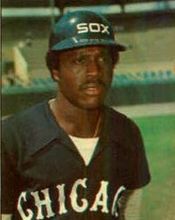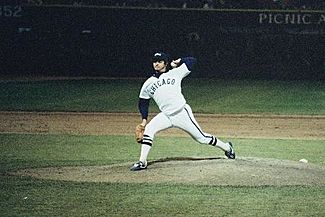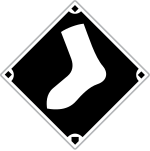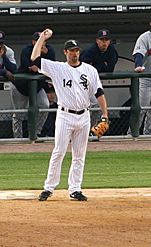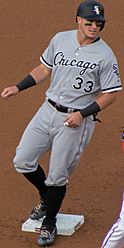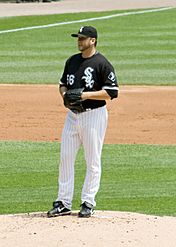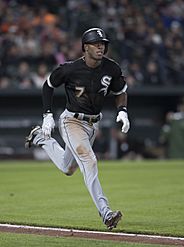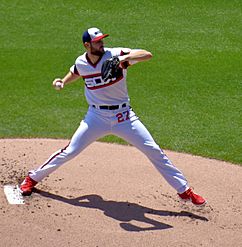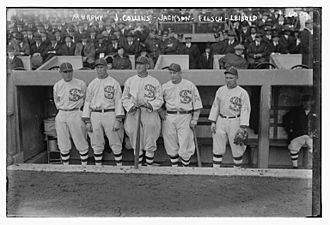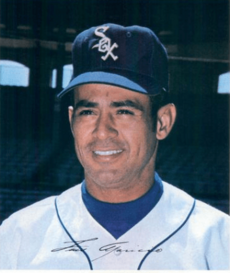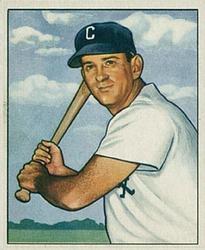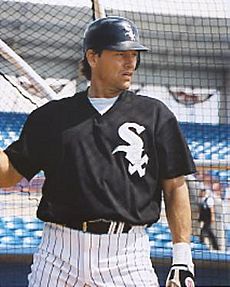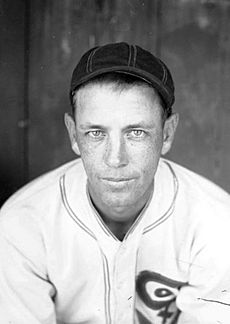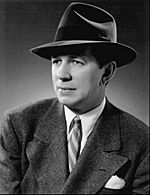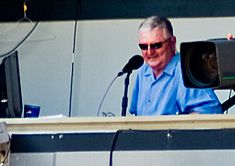Chicago White Sox facts for kids
Quick facts for kids Chicago White Sox |
|||||
|---|---|---|---|---|---|
|
|||||
|
|||||
| Major league affiliations | |||||
|
|||||
| Current uniform | |||||
| Retired numbers | |||||
| Colors | |||||
|
|||||
| Name | |||||
|
|||||
| Other nicknames | |||||
|
|||||
| Ballpark | |||||
|
|||||
| Major league titles | |||||
| World Series titles (3) |
|
||||
| AL Pennants (7) |
|
||||
| WL Pennants (1) |
|
||||
| AL West Division titles (2) |
|
||||
| AL Central Division titles (4) |
|
||||
| Wild card berths (1) |
|
||||
| Front office | |||||
| Principal owner(s) | Jerry Reinsdorf | ||||
| General manager | Chris Getz | ||||
| Manager | Will Venable | ||||
The Chicago White Sox are a professional baseball team from Chicago, Illinois. They play in Major League Baseball (MLB) as part of the American League (AL) Central Division. Their home games are played at Rate Field on Chicago's South Side. They are one of two MLB teams in Chicago, the other being the Chicago Cubs from the NL. Fans often call them the "South Siders" because of their ballpark's location.
The White Sox started as the Sioux City Cornhuskers in 1894. They moved to Saint Paul, Minnesota, becoming the St. Paul Saints. In 1900, they moved to Chicago and were called the Chicago White Stockings. In 1901, the American League became a major league, and the White Stockings were one of its first teams. The team shortened its name to the White Sox in 1904. They first played at South Side Park before moving to Comiskey Park in 1910. They played there until 1990, then moved to a new stadium in 1991, which is now called Rate Field.
The White Sox won their first World Series in 1906 against the Cubs. This team was known as "the Hitless Wonders" because they focused on defense. They won their second World Series in 1917 against the New York Giants. Their 1919 World Series appearance was famous for the Black Sox Scandal. Eight White Sox players were found to have worked with gamblers to lose games on purpose. The Commissioner of Baseball, Kenesaw Mountain Landis, banned these players from baseball for life.
Since that scandal, the White Sox have played in two more World Series. They lost to the Los Angeles Dodgers in 1959. Then, in 2005, they finally won their third championship against the Houston Astros. It took the White Sox 88 seasons to win another World Series, which was the longest wait in the American League.
Contents
Team History: From Cornhuskers to Champions
The White Sox began as the Sioux City Cornhuskers in 1894. This was part of a minor league called the Western League. In 1894, Charles Comiskey bought the team. He moved them to St. Paul, Minnesota, and they became the St. Paul Saints. In 1900, Comiskey moved the Saints to Chicago. They were renamed the Chicago White Stockings. This was the old name of Chicago's National League team, the Cubs.
Becoming a Major League Team
In 1901, the Western League became the new major league American League. The White Stockings won the first AL championship that year. The World Series did not start until 1903. The team, now called the Chicago White Sox, played in their first World Series in 1906. They beat the Cubs in six games.
Winning the World Series in 1917
The White Sox won another championship in 1917. They beat the New York Giants in six games. Stars like Eddie Cicotte and "Shoeless" Joe Jackson helped them win. The Sox were expected to win the 1919 World Series. However, they lost to the Cincinnati Reds in eight games.
The Black Sox Scandal and Its Impact
There were rumors that the 1919 series was fixed. A criminal investigation followed in 1920. Even though the players were found not guilty in court, Commissioner Kenesaw Mountain Landis banned eight of them for life. This event became known as the Black Sox Scandal. It greatly affected the team. They did not win another championship for 40 years.
New Owners and the "Go-Go White Sox"
The White Sox did not do well for many years. After Charles Comiskey passed away, his son J. Louis Comiskey took over. The team improved in the 1930s and 1940s. Manager Jimmy Dykes led them, with stars like Luke Appling and Ted Lyons. Their numbers, 4 and 16, were later retired.
After J. Louis Comiskey died, his wife Grace Comiskey owned the team. Later, her children Dorothy and Chuck took over. In 1958, Bill Veeck bought most of the team. Veeck was known for fun promotions. He added an "exploding scoreboard" and outfield showers at Comiskey Park.
From 1951 to 1967, the White Sox had many successful seasons. They were known as the "Go-Go White Sox." This was because they focused on speed and getting on base, not just hitting home runs. Famous players from this time included Minnie Miñoso, Nellie Fox, Luis Aparicio, Billy Pierce, and Sherm Lollar. From 1957 to 1965, Al López managed the team. In 1959, the White Sox won their first championship since 1919. They lost the 1959 World Series to the Los Angeles Dodgers.
Struggles and a New Era
In the late 1960s and 1970s, the White Sox struggled. They even played some home games in Milwaukee. There were talks of moving the team, but it did not happen. In 1972, Dick Allen won the American League MVP award, which was a bright spot. Bill Veeck returned as owner in 1975. In 1977, the team won 90 games. They were called the "South Side Hitmen."
After this, the team's performance dropped. The famous 1979 Disco Demolition Night event also happened. Veeck had to sell the team. Jerry Reinsdorf and Eddie Einhorn bought the team. The Reinsdorf era started well. The team won their first division title in 1983. Manager Tony La Russa led stars like Carlton Fisk, Harold Baines, and LaMarr Hoyt. La Russa was later fired but went on to become a Hall of Fame manager.
A New Ballpark and Modern Success
The White Sox struggled in the late 1980s. Chicago worked hard to keep the team in town. A new ballpark was approved in 1988. It was built across the street from the old Comiskey Park. The new park opened in 1991. It was first called new Comiskey Park, then U.S. Cellular Field, and now Rate Field. The park has been updated over the years to make it more modern and fan-friendly.
The White Sox did well in the 1990s and early 2000s. Frank Thomas became a team legend. He holds many team records. Other important players included Robin Ventura and Ozzie Guillén. The Sox won their division in 1993. They were in first place in 1994 when the season was cut short by a strike.
In 2004, Ozzie Guillén became the manager. In 2005, the Sox won 99 games and their division. Key players included Paul Konerko, Mark Buehrle, and A. J. Pierzynski. They swept the Boston Red Sox in the playoffs. Then they beat the Los Angeles Angels to win their first championship in 46 years. The White Sox then swept the Houston Astros in the 2005 World Series. This gave them their first World Championship in 88 years.
Guillén led the team to another division title in 2008. They won a special one-game playoff against the Minnesota Twins. Guillén left in 2011. Robin Ventura became the new manager. In 2015, the White Sox won their 9,000th game. Ventura resigned in 2016. Rick Renteria took over.
Rebuilding and Recent Seasons
Before the 2017 season, the White Sox traded away some star players. This was to get young talent and rebuild the team. They traded Chris Sale and Adam Eaton for players like Yoán Moncada and Lucas Giolito. They also traded José Quintana to the Cubs for prospects like Eloy Jiménez and Dylan Cease.
In 2018, the White Sox became the first MLB team to stop using plastic straws. This was part of a campaign to help the environment. On August 25, 2020, Lucas Giolito threw a no-hitter. He only allowed one batter to reach base. In 2020, the White Sox made the playoffs for the first time since 2008. They lost to the Oakland Athletics. Jose Abreu won the AL MVP award that year. Tony La Russa returned as manager in 2021. He became the oldest active manager in MLB.
On April 14, 2021, Carlos Rodon threw another no-hitter for the White Sox. On June 6, 2021, Tony La Russa won his 2,764th game as manager. This moved him to second place on the all-time wins list. On August 12, 2021, the White Sox played the New York Yankees in the first ever Field of Dreams game in Iowa. The White Sox won with a walk-off home run by Tim Anderson. On September 23, 2021, the White Sox won the American League Central Division.
In 2024, the White Sox had a very tough season. They had a 21-game losing streak. This was the longest losing streak for any MLB team since 1988. On September 1, they set a new team record for losses with 107. By September 27, they had lost 121 games. This was the most losses in modern MLB history, passing the 1962 Mets.
Home Ballparks: Where the Sox Play
The White Sox have played in several ballparks. Their current home is Rate Field.
Rate Field: The Current Home
In the late 1980s, the team thought about moving to Florida. But the Illinois governor and state government helped get money for a new stadium. The new Comiskey Park opened in 1991. It was designed just for baseball. It was later renamed U.S. Cellular Field in 2003 and Guaranteed Rate Field in 2016. In December 2024, it was renamed Rate Field.
The park was praised for its wide areas for fans and good views. It also had natural grass. Many changes have been made to the park over the years. These changes made it look better and more fun for fans. For example, some upper deck seats were removed in 2004. This made the stadium smaller but improved the view. New areas like the FUNdamentals Deck were added for kids. This area has batting cages and a small Tee Ball field. The old blue seats were replaced with green seats. In 2019, the safety netting was extended to protect more fans.
Past Ballparks: Comiskey Park and More
The St. Paul Saints first played at Lexington Park. When they moved to Chicago, they played at South Side Park. This park was known for its huge size, which meant fewer home runs.
After the 1909 season, the Sox moved to the new Comiskey Park. It was called the "Baseball Palace of the World." It started with 28,000 seats and grew to over 50,000. It was famous for its unique features, like an outdoor shower and an exploding scoreboard. When it closed in 1990, it was the oldest ballpark still used in Major League Baseball.
Spring Training Locations
The White Sox have held their spring training in many different places over the years. These locations include cities in Missouri, Alabama, Texas, Louisiana, Florida, and California. Since 2009, they have trained at Camelback Ranch in Phoenix, Arizona. This is a large, modern facility that they share with the Los Angeles Dodgers.
Team Look: Logos and Uniforms
The White Sox are known for changing their uniforms often. In 1960, they were the first major sports team to put players' last names on their jerseys.
In 1912, the White Sox used a large "S" logo with smaller "O" and "X" letters inside it. This logo is linked to their 1917 championship and the 1919 Black Sox team. This dark-blue logo was used for many years. In the 1940s, the team colors were mainly navy blue and red.
In the 1950s and 1960s, the logo changed to the word "SOX" in a fancy script. The "S" was larger than the other letters. Black was the main color during this "Go-Go Sox" era. In 1964, the main color went back to navy blue.
In 1971, the team's main color changed to red. Their pinstripes and caps also became red. In 1976, the uniforms changed again. The main color returned to navy. The team wore white jerseys at home and blue on the road. They even had the option to wear shorts for a short time, which was very unusual!
In 1980, new owners held a contest for new uniform designs. The winning design had "SOX" written across the front in a bold font. The team wore these uniforms when they won their division in 1983. After five years, these were replaced with a simpler look.
In 1990, the White Sox introduced a new logo. It was a simpler version of the 1949–63 "SOX" logo. They also brought in black pinstripes, similar to the "Go-Go Sox" era. Black became the main color, with silver trim. This style, with small changes, has been used ever since.
The White Sox have also worn special throwback uniforms. In 2021, they wore uniforms honoring the 1919 team for the Field of Dreams game. That same year, they wore "City Connect" uniforms. These were all black with silver pinstripes and "Southside" on the front. In 2025, a new "City Connect" uniform was revealed. It is red with black sleeves and pinstripes, similar to the Chicago Bulls.
Team Achievements and Awards
World Series Championships
The White Sox have won the World Series three times:
- 1906: Beat the Chicago Cubs 4–2
- 1917: Beat the New York Giants 4–2
- 2005: Swept the Houston Astros 4–0
American League Championships
The White Sox have won the American League championship seven times:
- 1900, 1901, 1906, 1917, 1919, 1959, 2005
Award-Winning Players and Managers
Many White Sox players and managers have won major awards.
Most Valuable Player (MVP) Awards
- Nellie Fox (1959)
- Dick Allen (1972)
- Frank Thomas (1993, 1994)
- Jose Abreu (2020)
Cy Young Award Winners (Best Pitcher)
- Early Wynn (1959)
- LaMarr Hoyt (1983)
- Jack McDowell (1993)
Rookie of the Year Award Winners
- Orestes "Minnie" Miñoso (1951)
- Luis Aparicio (1956)
- Gary Peters (1963)
- Tommie Agee (1966)
- Ron Kittle (1983)
- Ozzie Guillén (1985)
- José Abreu (2014)
Manager of the Year Award Winners
- Tony La Russa (1983)
- Jeff Torborg (1990)
- Gene Lamont (1993)
- Jerry Manuel (2000)
- Ozzie Guillén (2005)
Retired Jersey Numbers
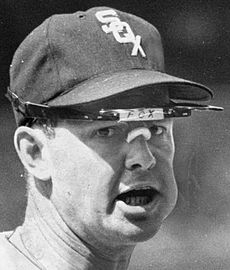

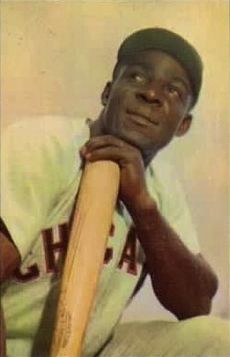
The White Sox have retired 12 jersey numbers. This means no other player can wear that number. Eleven numbers honor former White Sox players, and number 42 is retired across all of MLB for Jackie Robinson.
|
Numbers 6 (for Charley Lau) and 13 (for Ozzie Guillén) are also not used, but they are not officially retired.
Baseball Hall of Famers
Many players and people connected to the White Sox are in the National Baseball Hall of Fame. These include:
| Chicago White Sox Hall of Famers | |||||||||
|---|---|---|---|---|---|---|---|---|---|
| Affiliation according to the National Baseball Hall of Fame and Museum | |||||||||
|
Team Culture and Traditions
Team Nicknames
The White Sox were first called the White Stockings. Local newspapers shortened the name to Stox and Sox. Charles Comiskey officially adopted "White Sox."
Other nicknames include:
- The South Siders: Because their ballpark is on Chicago's South Side.
- The Pale Hose: Another name for "White Socks."
- The ChiSox: A mix of "Chicago" and "Sox," used to tell them apart from the Boston Red Sox.
- The Good Guys: From their old motto, "Good guys wear black."
- The Hitless Wonders: The 1906 team, who won the World Series despite not hitting many home runs.
- The Black Sox: The 1919 team, known for the scandal where players fixed games.
- The Go-Go White Sox: The 1959 team, known for their speed and getting on base.
- The South Side Hitmen: The 1977 team, who hit many home runs.
- Winning Ugly White Sox: The 1983 team, named after a rival manager said they were "winning ugly."
Team Mascots
For many years, a clown named Andy the Clown was an unofficial mascot. He would entertain fans at games. In 1981, the team introduced official mascots, Ribbie and Roobarb. Fans did not like them much.
In 1988, Ribbie and Roobarb were removed. Andy the Clown was not allowed to perform at the new ballpark. The team's current mascot, SouthPaw, was introduced in 2004. SouthPaw is a furry green creature who entertains young fans.
Team Songs and Music
Nancy Faust was the White Sox organist for 40 years. She was famous for playing pop music and songs that made fun of opposing players' names. Since 2011, Lori Moreland has been the organist.
Several songs are linked to the White Sox:
- "Let's Go Go Go White Sox": An old song from the "Go-Go White Sox" era. The team started playing it again in 2005, and it became a good luck charm.
- "Na Na Hey Hey Kiss Him Goodbye": Organist Nancy Faust started playing this song in 1977 when an opposing pitcher was taken out of the game. It became a huge hit with fans.
- "Sweet Home Chicago": The Blues Brothers' version of this song is played after White Sox home games.
- "Thunderstruck" by AC/DC: This song is often played when White Sox players are introduced. Fans love it.
- "Don't Stop Believin'" by Journey: The White Sox adopted this as their rally song in 2005. The band's singer even celebrated with the team after they won the World Series.
- "Don't Stop the Party" by Pitbull: This song plays over the loudspeakers after every White Sox home run.
Team Rivalries
Crosstown Classic: White Sox vs. Cubs
The Chicago Cubs are the White Sox's biggest rivals in Chicago. This rivalry is called the Crosstown Classic. For a long time, the teams only played exhibition games. They did not play official games until 1997, when interleague play started. The White Sox currently lead the regular-season series.
A famous moment in this rivalry happened on May 20, 2006. White Sox catcher A. J. Pierzynski crashed into Cubs catcher Michael Barrett at home plate. Barrett then punched Pierzynski, starting a big fight. After the fight, White Sox player Tadahito Iguchi hit a grand slam, and the White Sox won the game.
Divisional Rivals
Minnesota Twins
The rivalry between the White Sox and Minnesota Twins grew in the 2000s. The two teams often fought for the AL Central Division title. In 2008, they even played a special one-game playoff to decide the division winner. The White Sox won that game 1–0. The rivalry has continued in recent years.
Detroit Tigers
The series between the White Sox and Detroit Tigers is one of the oldest rivalries in baseball. Both teams joined the American League in 1901. They have played each other every year for over 120 seasons. Even though they have played more than 2,200 games, they have never met in the playoffs.
Community Involvement
In 1990, owners Jerry Reinsdorf and Eddie Einhorn started Chicago White Sox Charities. This group helps the community by giving money to many Chicago organizations. They focus on helping kids learn to read, encouraging high school graduation, and promoting health. They have donated over $27 million over the years.
Minor League Teams
The Chicago White Sox have six minor league teams. These teams help develop young players for the main team.
| Level | Team | League | Location | Ballpark | Affiliated |
|---|---|---|---|---|---|
| Triple-A | Charlotte Knights | International League | Charlotte, North Carolina | Truist Field | 1999 |
| Double-A | Birmingham Barons | Southern League | Birmingham, Alabama | Regions Field | 1986 |
| High-A | Winston-Salem Dash | South Atlantic League | Winston-Salem, North Carolina | Truist Stadium | 1997 |
| Single-A | Kannapolis Cannon Ballers | Carolina League | Kannapolis, North Carolina | Atrium Health Ballpark | 2001 |
| Rookie | ACL White Sox | Arizona Complex League | Glendale, Arizona | Camelback Ranch | 2014 |
| DSL White Sox | Dominican Summer League | Boca Chica, Santo Domingo | Baseball City Complex | 1999 |
Broadcasting the Games
Radio Broadcasts
For many years, Bob Elson was the main radio voice of the White Sox. He was known as the "Commander." Later, Harry Caray became a popular announcer for the team. He was famous for singing "Take Me Out To The Ballgame" with the fans.
Today, White Sox games are broadcast on WMVP (ESPN 1000). Len Kasper is the play-by-play announcer. Games are also broadcast in Spanish on WRTO (1200).
Television Broadcasts
White Sox games have been on TV since the early days. For a long time, Ken Harrelson was the main TV announcer. He was known as "Hawk" and was very passionate about the team. He retired after the 2018 season.
The White Sox games are now shown on NBC Sports Chicago. In 2024, John Schriffen became the new lead TV play-by-play announcer. For the 2025 season, the White Sox games moved to a new channel called Chicago Sports Network.
See also
 In Spanish: Chicago White Sox para niños
In Spanish: Chicago White Sox para niños




